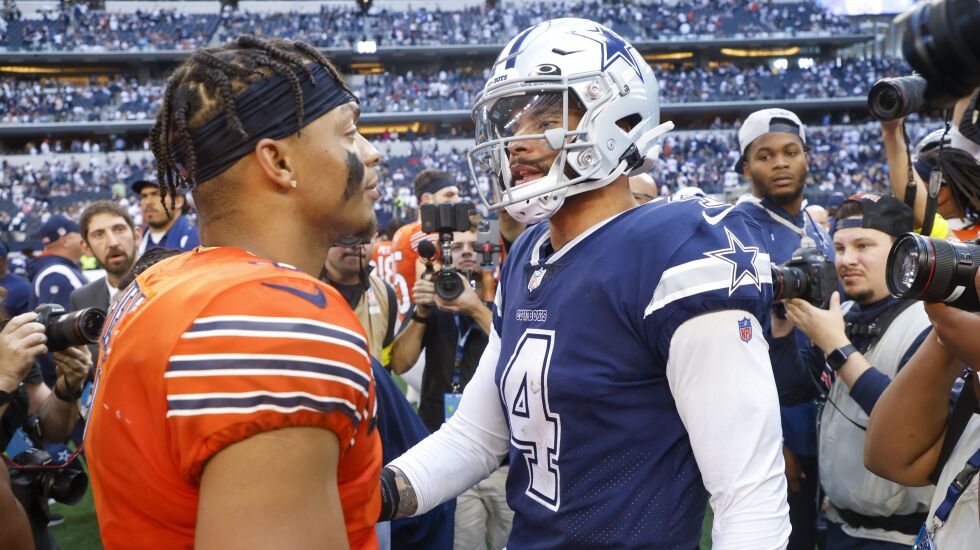
There’s no actual deadline looming for the Bears to decide what to do with quarterback Justin Fields. He’s under contract cheaply for next season, and general manager Ryan Poles can wait all the way until May — after the draft — to activate his reasonably priced option for 2025. Then he could use the franchise tag on him, if he had to.
They could go three more seasons trying to gauge whether his progress is substantial enough.
But that’s not what clarity at quarterback looks like.
Teams that play that game usually don’t like how it turns out. There’s urgency to commit or ditch. The Eagles were sure of what they had in Jalen Hurts and signed him to a massive contract extension. The Dolphins had trouble deciding on Ryan Tannehill, just as the Bengals were cautious about Andy Dalton, and neither team got where it wanted to go until it replaced them.
The extra wrinkle in the Bears’ situation is that while there is no hard deadline, having the No. 1 pick in a draft that features impressive quarterback prospects like Caleb Williams and Drake Maye creates a now-or-never scenario.
There’s no telling when they’ll have this opportunity again. The Bears have been beyond maddening over the last four decades, yet this will be just the fifth time they’ve had a top-five pick in that span — and they only have this one because they traded the No. 1 overall pick to the Panthers last year for future capital.
That’s why they need to know now on Fields.
Fortunately for the Bears’ evaluation process, he’ll wrap up his third season Sunday at the Packers, and teams almost always know what they have by that point.
The Bears have been incredibly turbulent during Fields’ time — imagine getting drafted No. 11 overall and walking into the dysfunction and incompetence of the final year of Ryan Pace and Matt Nagy as a rookie — but there is a sufficient body of work to analyze. This will be Fields’ 38th start, he has thrown over 900 passes and played more than 2,300 snaps, plus Poles and coach Matt Eberflus have seen every play of every practice for almost two full years.
Fields has improved and is trending upwardly. He’s a better player with a brighter future than the Bears’ last first-round quarterback, Mitch Trubisky. But in his third season, with imperfect-but-adequate infrastructure in place, he ranks 21st in passer rating (85.8), 22nd in yards passing per game (201.2), 28th in completion percentage (61), 20th in touchdown passes (16), and 14th in fewest interceptions (nine) out of 31 qualifying quarterbacks. He stands second in quarterback rushing at 630 yards. He also has lost four fumbles.
There is promise in Fields’ performance, but those numbers don’t measure up well compared to teams that hit jackpot at quarterback.
Eight teams currently have a franchise quarterback in his prime: the Dolphins’ Tua Tagovailoa, the Bills’ Josh Allen, the Ravens’ Lamar Jackson, the Bengals’ Joe Burrow, the Chiefs’ Patrick Mahomes, the Chargers’ Justin Herbert, the Cowboys’ Dak Prescott and the Eagles’ Jalen Hurts. Other teams believe they have their guy, but those players are either too young (the Texans’ C.J. Stroud and 49ers’ Brock Purdy) or too old (the Rams’ Matt Stafford and the Vikings’ Kirk Cousins) to include in this comparison.
From the aforementioned group of eight, here’s what they posted on average in their third season: 66.9 completion percentage, 259.6 yards passing per game, 27.3 touchdown passes, 8.5 interceptions and a 101.2 passer rating.
Four of them got huge contract extensions after Year 3, three others got them eventually and the only one who hasn’t, Tagovailoa, is in line for a whopping payday after this season.
And here’s the definition of whopping: Jackson, Burrow and Hurts signed five-year deals last offseason ranging from $255 million to $275 million with an average of $207.6 million guaranteed. Mahomes got $450 million over 10 years in 2023 and already has renegotiated for more.
Once a team goes all-in on a quarterback like that, as the Giants are finding with Daniel Jones and the Cardinals with Kyler Murray, there is no pivot.
The only quarterbacks of that eight-player sample below a 100 passer rating in Year 3 were Jackson (99.3, but won MVP in Year 2), Herbert (93.2, but won offensive rookie of the year) and Prescott (96.9, but also won offensive rookie of the year).
The list of quarterbacks since 2010 who had a sub-90 passer rating in the third season is mostly unglamourous and includes Trubisky at 83.0. The ones who turned out the best were Dalton, Cousins and Cam Newton.
Looking at Fields’ fellow first-round picks from 2021, he has proven himself better than anyone in the class except the Jaguars’ Trevor Lawrence, who went No. 1 overall.
And Lawrence’s statistics aren’t dramatically better than Fields, but the Jaguars will give him more of a runway because of what a highly touted prospect he was — widely thought to be the most can’t-miss quarterback since Andrew Luck in 2012 — and they’re currently slotted to pick 22nd in the draft. Also, the general manager who drafted him is still there, whereas Poles inherited Fields from Pace.
If the Bears were picking as low as the Jaguars, they’d be sticking with Fields to see what he can show them next season. Their own pick is 10th now and could slide as far back as 16th depending on what happens this weekend. It’s having that No. 1 pick that complicates Poles’ decision, albeit to the franchise’s advantage. Having options is always a good thing.
It’s also what makes the Bears the most intriguing team to watch in the upcoming offseason, which starts Sunday night for them. No non-playoff team has been debated as much as they have over the past month, and it’ll only heat up from here. So while they’ve still got some climbing to do to contend, at least they’re interesting.







